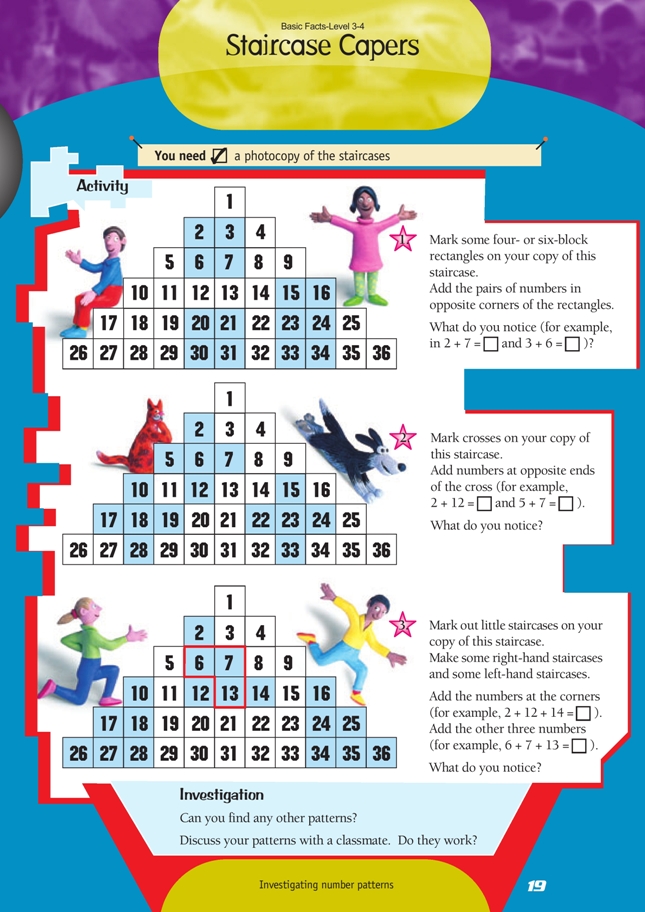This is a level 3 algebra activity from the Figure It Out series.
A PDF of the student activity is included.
Click on the image to enlarge it. Click again to close. Download PDF (150 KB)
explore patterns in numbers
photocopy of the staircases
In this activity, the students are looking for patterns in numbers. They will need to try several squares, crosses, or staircases before they can be sure that they have found the correct pattern.
Students could use a calculator to speed up their operations, but discourage them from using a calculator for simple operations.
Investigation
As the students investigate different patterns, you could ask the following questions to extend their thinking:
“Will it always work?”
“Would it work on a bigger shape?”
“What other patterns can you make?”
“Can you find out anything about the numbers on diagonal lines?”
“What will happen if you multiply the numbers?”
“What happens for vertical and horizontal lines?”
“Why does it work?”
For example:
Students may also enjoy investigating patterns of numbers in other situations, for example, in calendar months or hundreds squares. Do the same patterns work?
Here is one pattern that compares 3 x 3 grids on the staircases and on a calendar.
Choose a 3 x 3 set of numbers from one of the staircases. For example:
Double the middle number (13 x 2 = 26). Now take any two numbers on the outside of the grid that are directly opposite each other (vertically, horizontally, or diagonally), for example, 7 and 21. Adding them gives 7 + 21 = 28, which is two more than 26. The same is true for 6 and 22, which give 28 when added. Create a new 3 x 3 grid from the staircase and check if the rule holds.
If you do this with a calendar, it gets even more interesting. For example, a grid from the calendar for May 2001 will look like this:
The middle number is 16, and 16 x 2 = 32. Pick a pair of opposite numbers, say 15 and 17. 15 + 17 = 32. Another pair is 10 + 22 = 32.
Use a calendar and check if this rule holds true for any 3 x 3 grid that you pick.
Answers to Activity
1. In each rectangle, pairs of numbers in opposite corners of the rectangle are equal.
2. In each cross, the sum of the two horizontal numbers added is 2 less than the sum of the two vertical numbers added.
3. The sum of the three corner numbers is always 2 more than the sum of the other three numbers in the staircase.
Investigation
Answers will vary and will include different shapes.
For example:
• triangles, such as
• alphabet letters, for example, Z
• multiplying opposite corners
• comparing a 3 x 3 set of numbers on one of the staircases to 3 x 3 grids on a calendar.



